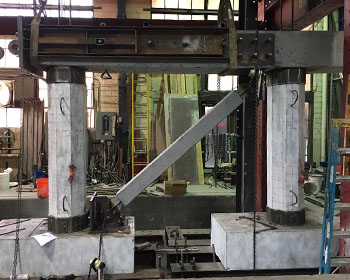MPC Research Reports
Report Details
Abstract
 A new method for building seismically resilient bridges is proposed using accelerated bridge construction (ABC) methods. The hybrid two-column bridge bent consists of post-tensioned precast concrete columns with a buckling restrained brace (BRB) as an external energy dissipation device. The design of initial post-tensioning forces and the selection of the appropriate strength of the BRB is provided. The connection design for such configuration considering the free rocking of the columns and the experimental performance of the hybrid bridge bent subjected to cyclic loads is presented. The BRB used had two steel cores; the first BRB steel core fractured during the 5.0% drift ratio, and the second steel core fractured during the 6.0% drift ratio. The two unbonded post-tensioned (PT) bars of the west column yielded after fracture of the BRB steel cores, while the two PT bars of the east column did not yield. The precast concrete elements of the hybrid bridge bent remained undamaged up to 6.0% drift ratio. The longitudinal mild steel bars of the columns did not yield until the 6.0% drift ratio. The gusset assemblies at the cap beam and the footing remained elastic. The damaged BRB could be easily replaced after an earthquake, and the steel gussets could be used to re-center the bridge bent; thus, the proposed system is promising for constructing resilient bridges using ABC methods in high seismic regions that should remain functional after an earthquake.
A new method for building seismically resilient bridges is proposed using accelerated bridge construction (ABC) methods. The hybrid two-column bridge bent consists of post-tensioned precast concrete columns with a buckling restrained brace (BRB) as an external energy dissipation device. The design of initial post-tensioning forces and the selection of the appropriate strength of the BRB is provided. The connection design for such configuration considering the free rocking of the columns and the experimental performance of the hybrid bridge bent subjected to cyclic loads is presented. The BRB used had two steel cores; the first BRB steel core fractured during the 5.0% drift ratio, and the second steel core fractured during the 6.0% drift ratio. The two unbonded post-tensioned (PT) bars of the west column yielded after fracture of the BRB steel cores, while the two PT bars of the east column did not yield. The precast concrete elements of the hybrid bridge bent remained undamaged up to 6.0% drift ratio. The longitudinal mild steel bars of the columns did not yield until the 6.0% drift ratio. The gusset assemblies at the cap beam and the footing remained elastic. The damaged BRB could be easily replaced after an earthquake, and the steel gussets could be used to re-center the bridge bent; thus, the proposed system is promising for constructing resilient bridges using ABC methods in high seismic regions that should remain functional after an earthquake.
This report also contributes to development of an analytical model and modeling approach of a double rocking bridge bent consisting of two octagonal columns with two post-tensioned bars each and detached joints using OpenSees. The modeling of rocking mechanisms at the joint of the precast members that are joined by PT bars and BRB as external energy dissipation devices is discussed. The results of the analytical modeling of such hybrid bridge bents under quasi-static cyclic loads are discussed and compared with the experimental results. Numerical simulation demonstrates that the results from the analytical model agree with the experiments in terms of structural response, cumulative hysteretic energy, and joint movement of the test specimens. The response of the BRB is well captured by the analytical model, and the exact amount of energy dissipated by the energy dissipator was obtained and compared to the total amount of the energy dissipated by the bent. The influence of adding an energy-dissipating element on the performance of the bridge bent is analyzed.
The numerical model is subsequently extended to a previously tested three-column bridge bent for a configuration, which included two BRBs. A fiber-based bridge bent model, which includes soil-structure interaction (SSI) using simplified springs, is built. Seismic analyses of hybrid bridge bents using far-field and near-field ground motions show that the hybrid bridge bent displays superior performance.
How to Cite
Pantelides, Chris, and Ijan Dangol. Hybrid Bridge Bents Using Post-tensioned Precast Columns for Accelerated Bridge Construction in High Seismic Regions, MPC-22-474. North Dakota State University - Upper Great Plains Transportation Institute, Fargo: Mountain-Plains Consortium, 2022.

